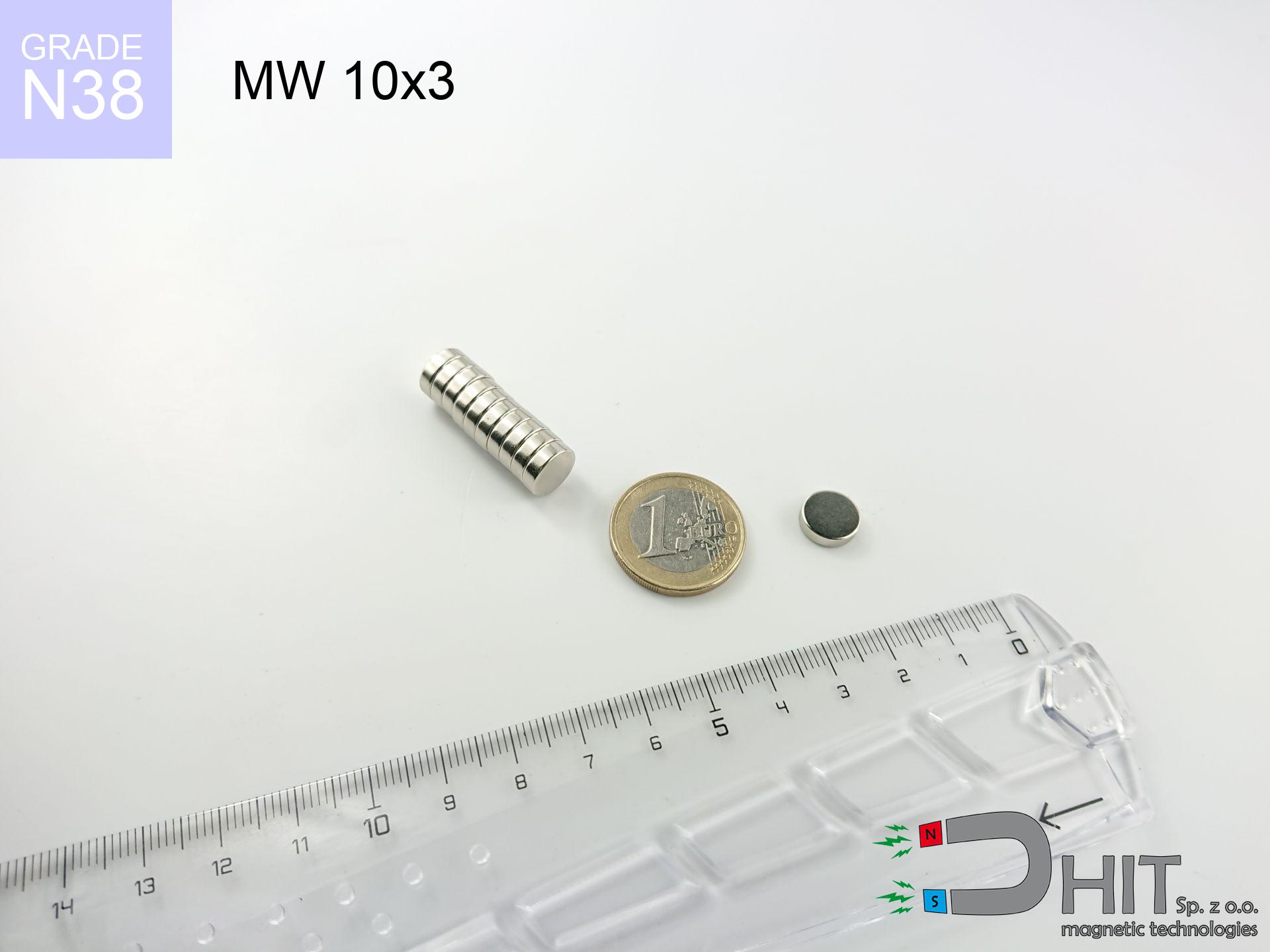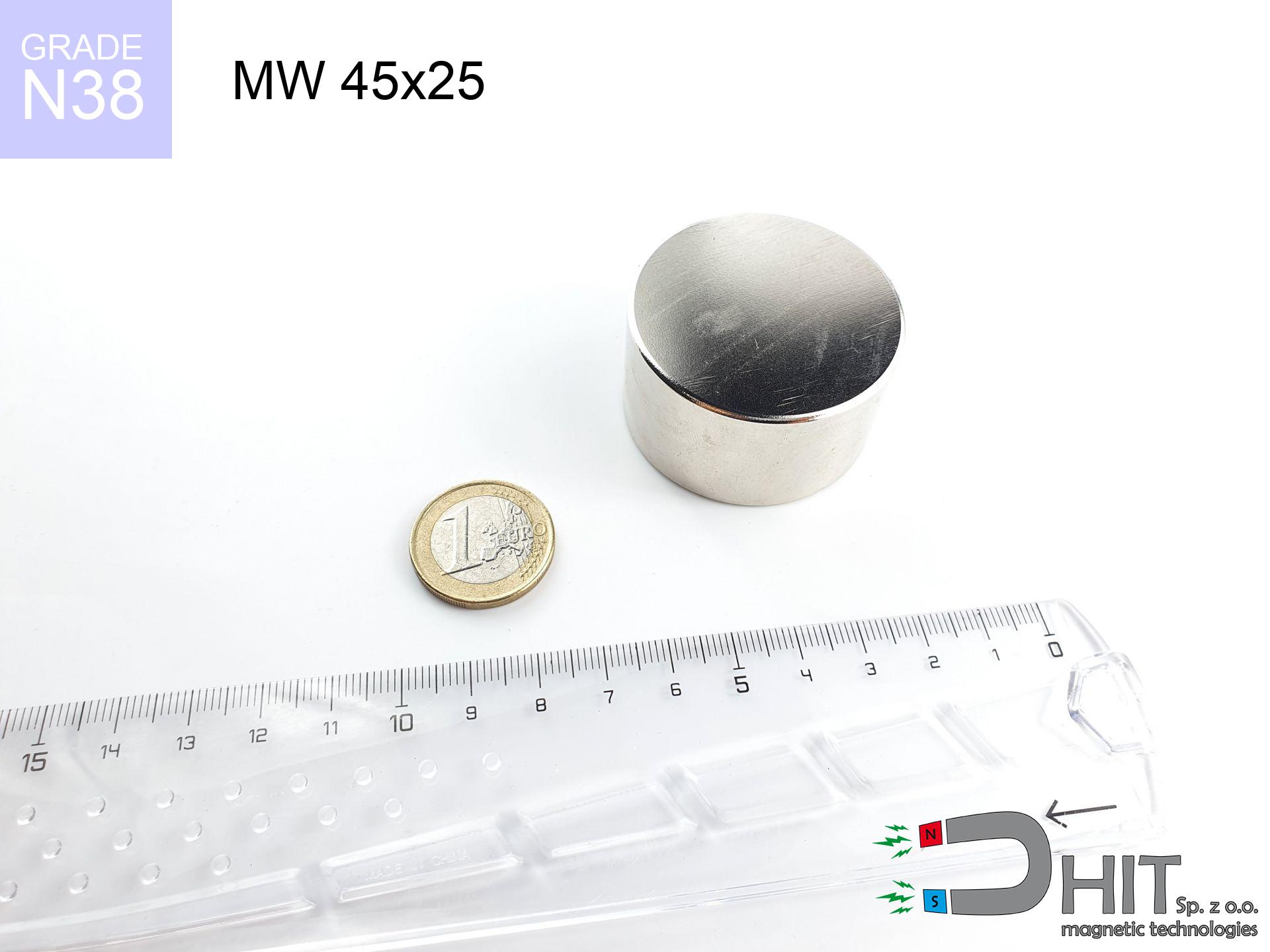MW 10x3 / N38 - cylindrical magnet
cylindrical magnet
Catalog no 010008
GTIN: 5906301810070
Diameter Ø [±0,1 mm]
10 mm
Height [±0,1 mm]
3 mm
Weight
1.77 g
Magnetization Direction
↑ axial
Load capacity
1.66 kg / 16.28 N
Magnetic Induction
318.70 mT
Coating
[NiCuNi] nickel
0.726 ZŁ with VAT / pcs + price for transport
0.590 ZŁ net + 23% VAT / pcs
bulk discounts:
Need more?Hunting for a discount?
Give us a call
+48 22 499 98 98
or contact us through
contact form
our website.
Force and shape of magnetic components can be analyzed using our
online calculation tool.
Orders submitted before 14:00 will be dispatched today!
Magnetic properties of material N38
Physical properties of sintered neodymium magnets Nd2Fe14B at 20°C
Shopping tips
Strengths as well as weaknesses of neodymium magnets.
Apart from their notable magnetism, neodymium magnets have these key benefits:
- They virtually do not lose strength, because even after ten years the decline in efficiency is only ~1% (according to literature),
- They have excellent resistance to weakening of magnetic properties as a result of external fields,
- By covering with a lustrous layer of gold, the element presents an modern look,
- Neodymium magnets achieve maximum magnetic induction on a small surface, which increases force concentration,
- Thanks to resistance to high temperature, they are able to function (depending on the shape) even at temperatures up to 230°C and higher...
- Possibility of precise modeling as well as adjusting to specific needs,
- Key role in electronics industry – they find application in hard drives, electric motors, diagnostic systems, as well as other advanced devices.
- Compactness – despite small sizes they offer powerful magnetic field, making them ideal for precision applications
Disadvantages of neodymium magnets:
- Susceptibility to cracking is one of their disadvantages. Upon intense impact they can break. We recommend keeping them in a steel housing, which not only protects them against impacts but also increases their durability
- We warn that neodymium magnets can reduce their power at high temperatures. To prevent this, we advise our specialized [AH] magnets, which work effectively even at 230°C.
- Magnets exposed to a humid environment can rust. Therefore when using outdoors, we suggest using water-impermeable magnets made of rubber, plastic or other material protecting against moisture
- Limited possibility of making threads in the magnet and complicated forms - recommended is casing - magnetic holder.
- Possible danger to health – tiny shards of magnets are risky, in case of ingestion, which becomes key in the context of child health protection. It is also worth noting that tiny parts of these magnets can complicate diagnosis medical after entering the body.
- Higher cost of purchase is a significant factor to consider compared to ceramic magnets, especially in budget applications
Maximum lifting force for a neodymium magnet – what contributes to it?
The specified lifting capacity refers to the peak performance, measured under optimal environment, meaning:
- with the application of a sheet made of special test steel, ensuring maximum field concentration
- possessing a massiveness of min. 10 mm to ensure full flux closure
- characterized by lack of roughness
- without any insulating layer between the magnet and steel
- for force applied at a right angle (in the magnet axis)
- at temperature approx. 20 degrees Celsius
Practical aspects of lifting capacity – factors
In practice, the actual lifting capacity is determined by a number of factors, ranked from most significant:
- Gap (between the magnet and the metal), as even a microscopic clearance (e.g. 0.5 mm) leads to a reduction in force by up to 50% (this also applies to varnish, rust or dirt).
- Force direction – remember that the magnet holds strongest perpendicularly. Under sliding down, the holding force drops significantly, often to levels of 20-30% of the maximum value.
- Element thickness – to utilize 100% power, the steel must be adequately massive. Paper-thin metal limits the lifting capacity (the magnet "punches through" it).
- Material type – ideal substrate is pure iron steel. Stainless steels may attract less.
- Surface finish – ideal contact is possible only on smooth steel. Rough texture create air cushions, reducing force.
- Thermal environment – temperature increase results in weakening of force. Check the maximum operating temperature for a given model.
* Lifting capacity testing was performed on plates with a smooth surface of optimal thickness, under a perpendicular pulling force, in contrast under attempts to slide the magnet the lifting capacity is smaller. In addition, even a slight gap {between} the magnet and the plate lowers the holding force.
H&S for magnets
Nickel allergy
Nickel alert: The Ni-Cu-Ni coating consists of nickel. If an allergic reaction occurs, immediately stop working with magnets and use protective gear.
Precision electronics
A strong magnetic field disrupts the functioning of compasses in phones and navigation systems. Keep magnets close to a smartphone to avoid breaking the sensors.
Dust is flammable
Dust generated during grinding of magnets is combustible. Avoid drilling into magnets unless you are an expert.
Caution required
Use magnets with awareness. Their huge power can shock even experienced users. Stay alert and respect their force.
Product not for children
Strictly store magnets away from children. Ingestion danger is significant, and the effects of magnets connecting inside the body are tragic.
Warning for heart patients
Warning for patients: Strong magnetic fields disrupt medical devices. Keep at least 30 cm distance or ask another person to work with the magnets.
Do not overheat magnets
Keep cool. Neodymium magnets are sensitive to heat. If you need resistance above 80°C, inquire about special high-temperature series (H, SH, UH).
Protect data
Powerful magnetic fields can destroy records on credit cards, hard drives, and other magnetic media. Stay away of at least 10 cm.
Pinching danger
Large magnets can break fingers instantly. Do not put your hand between two attracting surfaces.
Shattering risk
Protect your eyes. Magnets can explode upon uncontrolled impact, ejecting sharp fragments into the air. Wear goggles.
Important!
Looking for details? Read our article: Are neodymium magnets dangerous?







![UMGZ 48x24x11.5 [M8] GZ / N38 - magnetic holder external thread UMGZ 48x24x11.5 [M8] GZ / N38 - magnetic holder external thread](https://cdn3.dhit.pl/graphics/products/umgw-48x24x11.5-m8-gz-bit.jpg)

